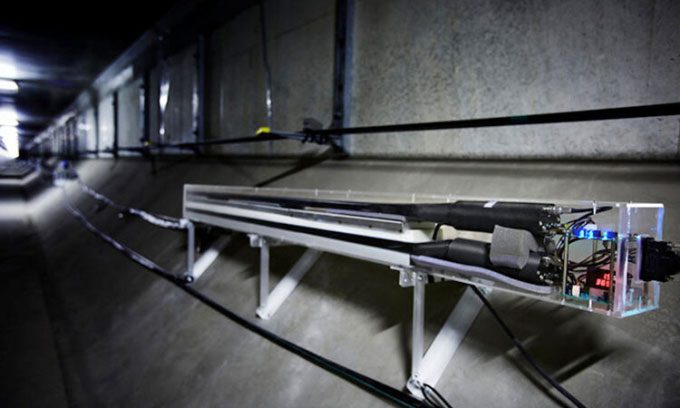The muon detection system in a tunnel beneath Tokyo Bay can detect muon particle fluctuations in the ocean, aiding in tsunami recognition.
Tsunamis can have catastrophic consequences, prompting scientists to enhance measures for detecting this natural disaster. A study published in the journal Scientific Reports on April 12 highlights a promising solution for tsunami detection: monitoring muon particles.
Muons are high-energy elementary particles generated when cosmic rays from space strike the Earth. They are ubiquitous in the atmosphere and can pass through almost anything harmlessly. Approximately 100,000 muons pass through a human body in just a few seconds. Their trajectories can be slightly altered by significant natural forces, including tsunamis.

The detector is approximately 2 meters long in the tunnel beneath Tokyo Bay. (Photo: Hiroyuki Tanaka/Muographix)
To detect the movement of muon particles, a highly sensitive instrument is required, such as the TS-HKMSDD detector located in Tokyo Bay, Japan. This device is installed within the Tokyo Bay Aqua-Line expressway tunnel. The new study indicates that the TS-HKMSSD has successfully detected a tsunami through fluctuations in muon particles for the first time. This detection occurs in real-time and has proven to be highly accurate.
“TS-HKMSSD is the world’s first underwater muon observatory, and it has detected changes in muon activity during a tsunami. These changes correspond to ocean level rises measured by other methods. Combining these results means we can use muon data to accurately model changes in sea levels, bypassing the drawbacks of other methods,” said geophysicist Hiroyuki Tanaka from the University of Tokyo.
Other methods include tide gauges, buoys, aerial satellite imagery, and various ocean sensors. However, the muon monitoring method promises to be faster, cheaper, and easier to maintain than the aforementioned techniques.
The new study presents how the TS-HKMSDD system detected a minor tsunami that swept through Tokyo Bay in September 2021, caused by a storm approaching Japan from the south. As the ocean fluctuated, the number of muons changed slightly, dispersing through the volume of water.
The research team proposes installing similar TS-HKMSSD devices in other tunnels in tsunami-prone areas and using them alongside tide gauges, making them part of an early warning system. “Thanks to the success of such initial tests, similar systems are also being tested in the UK and Finland,” Tanaka noted.
Muon detectors that make up the TS-HKMSSD system are relatively small, measuring only about 2 meters in length. Currently, 20 such detectors are positioned along the tunnel beneath Tokyo Bay. In addition to detecting incoming tsunamis, such a system could be used to search for natural gas reserves and identify ancient earthquake patterns.
At present, the research team is pleased to use the TS-HKMSSD as an accurate tsunami detector. In the future, this system may help alert experts to natural disasters. “As far as I know, this tunnel is the first operational national road in the world identified as a laboratory”, Tanaka stated.

















































